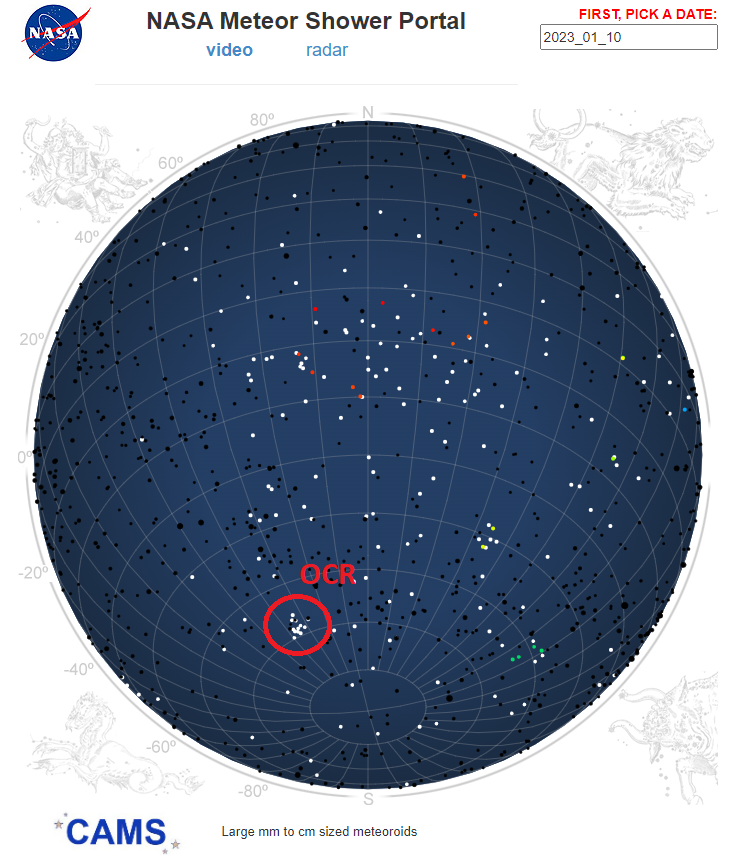Before January 10th, 2023, only a few omega-Carinids had ever been recorded : 3 of them in 2020 and 2021, and 5 members during what looks like a small outburst in 2016 (recorded by the CAMS from New-Zealand on Jan 9th, between 12h 31min and 13h 58min UT, i.e. solar longitude 288.51° +/-0.01°). This year, according to Peter Jenniskens (SETI Institute and NASA Ames Research Center), Steve Heathcote and Tim Abbott (NOIRLAB and Certo Tololo Interamerican Observatory) and Emmanuel Jehin (University of Liege), the number of observed omega-Carinids has more than doubled, as 11 of this low activity meteor shower have been recorded on January 10th from 02h to 08h UT (which equals solar longitude from 289.22° to 289.48°, centered on 289.35+/-0.03° (equinox J2000.0)) by CAMS network from Southern hemisphere, especially video stations located in Chile (Figure 1).

Omega-Carinids, a minor meteor shower
The recorded meteors belong to a minor source numbered #1033 by the International Astronomical Union, and called omega-Carinids (OCR). It is very likely to be linked to an unknown long-period comet (see orbital parameters below).
This small outburst allowed to calculate more accurate shower parameters.
Last figures are:
- radiant right ascension = 153.84°
- radiant declination = -73.46°
- V = 40.9 km/s
- a = 46.9 AU
- q = 0.958+/-0.001 AU
- e = 0.986+/-0.062
- i = 66.9+/-0.7°
- argument of perihelion = 341.3+/-0.7°
- longitude of ascending node = 109.35°+/-0.03°
Sources
- IAU Meteor Data Center
- CAMS Seti
- CBET n°5207 (see below)
Electronic Telegram No. 5207
Central Bureau for Astronomical Telegrams
Mailing address: Hoffman Lab 209; Harvard University;
20 Oxford St.; Cambridge, MA 02138; U.S.A.
e-mail: cbatiau@eps.harvard.edu (alternate cbat@iau.org)
URL http://www.cbat.eps.harvard.edu/index.html
Prepared using the Tamkin Foundation Computer Network
OMEGA CARINID METEOR SHOWER 2023
P. Jenniskens, SETI Institute and NASA Ames Research Center; S. Heathcote
and T. Abbott, NOIRLAB and Cerro Tololo Interamerican Observatory; and E.
Jehin, University of Liege, report that the minor meteor shower omega Carinid
(IAU shower 1033) showed unusual activity between 2023 Jan. 10d02h and 10d08h
UTC (cf. http://cams.seti.org/FDL/ for the date of 2023 Jan. 10). The CAMS
Chile network triangulated eleven meteors from this shower during the solar
longitude interval from 289.22 to 289.48 deg, centered on 289.35 +/- 0.03 deg
(equinox J2000.0). In prior years 2020 and 2021, only three omega Carinids
were triangulated in this solar longitude range by all southern-hemisphere
CAMS networks combined. The shower originates from an unknown long-period
comet and had median orbital elements q = 0.958 +/- 0.001 AU, e = 0.986 +/-
0.062, i = 66.9 +/- 0.7 deg, Peri = 341.3 +/- 0.7 deg, Node = 109.35 +/- 0.03
deg. During what may have been a prior meteor outburst in 2016, five omega
Carinids were triangulated by the CAMS New Zealand network (coordinated by
W. J. Baggaley, University of Christchurch) during the 1.5 hr between Jan.
9d12h31m and 9d13h58m UTC, centered on solar longitude 288.51 +/- 0.01 deg.
NOTE: These 'Central Bureau Electronic Telegrams' are sometimes
superseded by text appearing later in the printed IAU Circulars.
(C) Copyright 2023 CBAT
2023 January 14 (CBET 5207) Daniel W. E. Green




 You saw something bright and fast? Like a huge shooting star? Report it: it may be a fireball.
You saw something bright and fast? Like a huge shooting star? Report it: it may be a fireball.  You counted meteors last night? Share your results with us!
You counted meteors last night? Share your results with us!  You took a photo of a meteor or fireball? You have a screenshot of your cam? Share it with us!
You took a photo of a meteor or fireball? You have a screenshot of your cam? Share it with us!  You caught a meteor or fireball on video? Share your video with us!
You caught a meteor or fireball on video? Share your video with us!